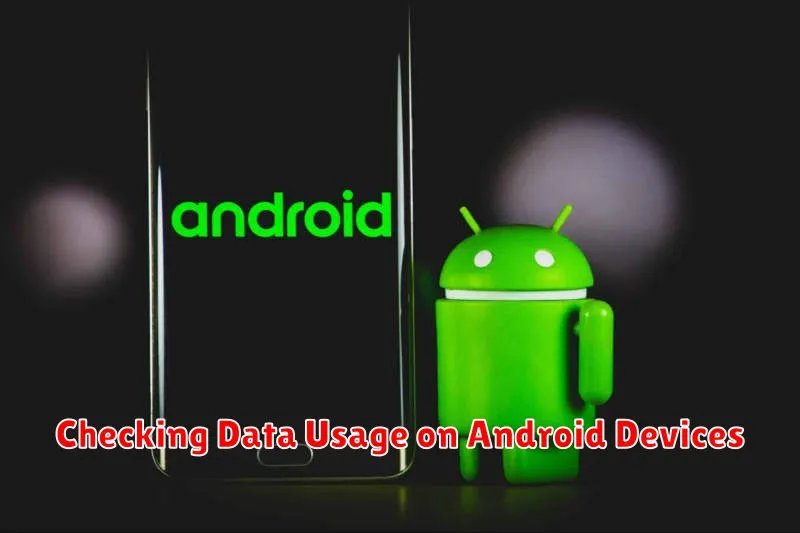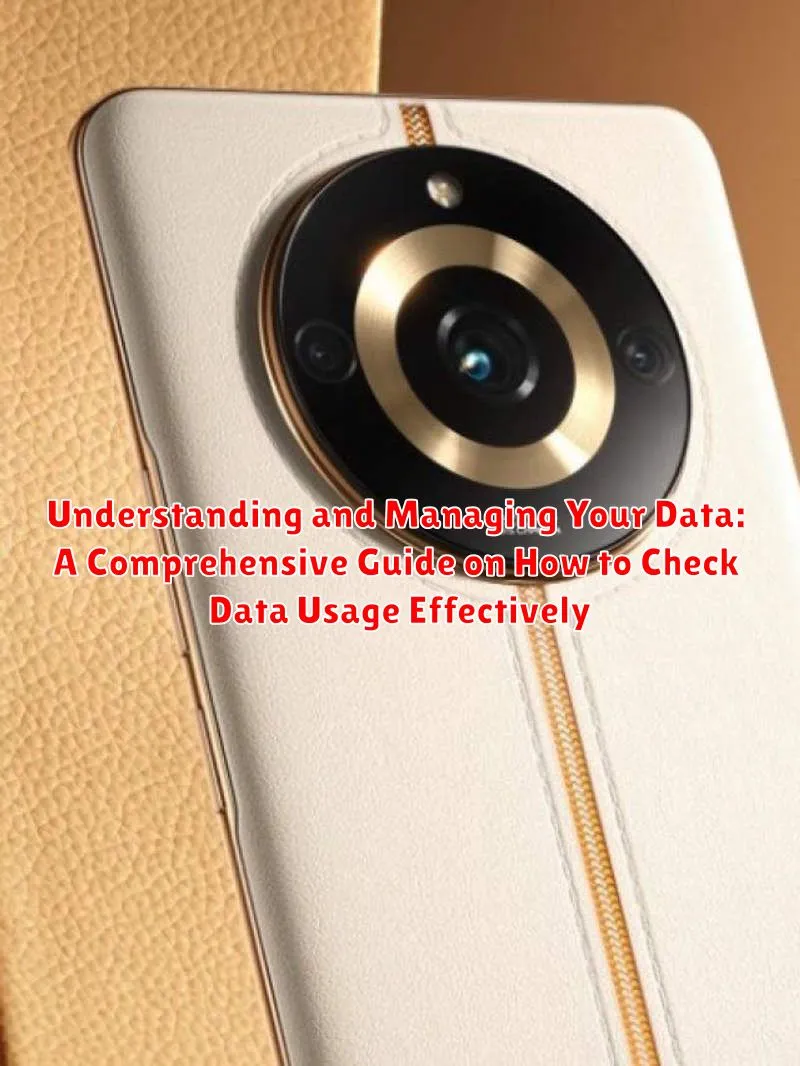In today’s digital age, understanding and managing your data is more crucial than ever. With the proliferation of smartphones, tablets, and internet-connected devices, individuals and businesses alike generate and consume vast quantities of data daily. This data usage impacts everything from your monthly bills to the performance of your devices. This comprehensive guide, titled “Understanding and Managing Your Data: A Comprehensive Guide on How to Check Data Usage Effectively,” aims to empower you with the knowledge and tools necessary to effectively monitor, control, and optimize your data consumption across various platforms.
This guide will walk you through the various methods for checking data usage on different operating systems (like Android, iOS, Windows, and macOS) and devices. We will also delve into strategies for reducing data consumption, understanding data plans, and avoiding unexpected charges. By mastering these techniques, you can gain greater control over your digital footprint, save money, and ensure that your devices perform optimally.
Why Monitoring Your Data Usage is Crucial
In today’s digitally driven world, monitoring your data usage is no longer a mere convenience; it’s an essential practice for effective financial management and avoiding unexpected service interruptions.
Failing to track your data consumption can lead to surprising overage charges on your monthly bill. These charges can accumulate quickly, impacting your budget negatively. By regularly checking your data usage, you can stay within your allocated data limit and avoid these unnecessary expenses.
Furthermore, monitoring data usage helps you understand your online habits. Identifying which apps and activities consume the most data allows you to make informed decisions about your internet usage. This awareness enables you to adjust your behavior to stay within your data plan and optimize your online experience.
Checking Data Usage on Android Devices

Monitoring data usage on your Android device is straightforward. Android provides built-in tools to track your data consumption, ensuring you stay within your data plan.
Steps to Check Data Usage:
- Open the Settings app on your Android device.
- Tap on “Connections” or “Network & Internet”, depending on your device’s manufacturer.
- Select “Data Usage”. Here, you’ll see an overview of your mobile data usage for the current billing cycle.
- To view more detailed information, tap on “Mobile Data Usage”.
This section displays a graph showing your data usage over time, as well as a list of apps and the amount of data each has consumed. You can also select a specific date range to analyze data usage for that period. Tapping on individual apps provides further details, including foreground and background data usage.
How to Check Data Usage on iPhones and iPads
Monitoring data usage on your iPhone or iPad is essential to avoid exceeding your monthly data allowance. Apple provides built-in tools to help you track your data consumption.
Checking Cellular Data Usage
To check your cellular data usage, follow these steps:
- Open the Settings app.
- Tap on Cellular.
- Scroll down to view the Cellular Data Usage section. This section displays the current period usage and lifetime usage.
You can reset statistics at the bottom of the page to track usage from your current billing cycle.
Checking Wi-Fi Data Usage
While the primary focus is often cellular data, you can also see how much data you’ve used over Wi-Fi. This information is located within the same Cellular settings page, below the cellular data statistics.
Understanding Data Usage Settings on Your Device
Gaining a clear understanding of the data usage settings on your device is essential for effective data management. These settings provide valuable insights into how your data is being consumed and offer tools to control and optimize your usage.
Accessing Data Usage Settings
On most devices, data usage settings can be found within the Settings app. Look for sections labeled “Data Usage,” “Mobile Data,” or similar terms. The precise location may vary depending on your device’s operating system and manufacturer.
Key Features and Options
Within the data usage settings, you’ll typically find the following features:
- Data Usage Overview: A graphical representation of your data consumption over a specified period.
- App-Specific Data Usage: A breakdown of how much data each app has used.
- Background Data Restrictions: Options to limit or disable background data usage for individual apps.
- Data Saver Mode: A system-wide setting that reduces data consumption by limiting background activity and compressing data.
By exploring these settings, you can proactively manage your data usage and prevent unexpected overages.
Tips for Reducing Mobile Data Consumption
Mobile data consumption can quickly add up, leading to unexpected charges and slower speeds. Fortunately, there are several strategies you can implement to minimize your data usage and stay within your allotted monthly limit.
Strategies for Data Reduction
- Use Wi-Fi Whenever Possible: Connect to Wi-Fi networks for data-intensive activities like streaming videos, downloading large files, and updating apps.
- Download Content for Offline Use: Many streaming services allow you to download movies, TV shows, and music for offline playback.
- Disable Background App Refresh: Limit the ability of apps to refresh in the background, as this can consume a significant amount of data.
- Optimize Streaming Settings: Adjust the quality of streaming videos and music to a lower resolution or bitrate.
- Monitor Social Media Usage: Social media apps can be data-heavy. Be mindful of auto-playing videos and image loading settings.
- Use Data Compression Browsers: Consider using browsers that compress data before loading web pages.
- Update Apps Over Wi-Fi: Avoid updating apps over mobile data, as these updates can be large.
By incorporating these data-saving techniques into your daily routine, you can significantly reduce your mobile data consumption and avoid exceeding your data limit.
Using Carrier Apps to Monitor Data Usage
Most mobile carriers offer their own dedicated apps that allow you to monitor your data usage in real-time. These apps are generally free to download and provide a comprehensive overview of your account, including data consumption.
Benefits of using carrier apps:
- Accurate Data Tracking: The data usage information provided by carrier apps is directly from your provider, ensuring accuracy.
- Real-Time Updates: Many apps offer real-time or near real-time updates, allowing you to track your usage throughout the day.
- Bill Management: Some apps also provide access to billing information, payment options, and customer support.
- Customized Alerts: You can often set up customized data usage alerts to notify you when you’re approaching your data limit.
To access this feature, download your carrier’s app from the App Store (iOS) or Google Play Store (Android), then log in using your account credentials. The app will typically display your current data usage, remaining data allowance, and the billing cycle’s end date.
Setting Data Usage Alerts and Limits on Android
Android devices offer built-in features to help you monitor and control your data usage. Setting alerts and limits can prevent unexpected charges and ensure you stay within your allocated data plan.
To set a data usage alert:
- Open your device’s Settings app.
- Tap on Network & internet, then Data usage.
- Select Mobile data usage.
- Tap the Settings icon (usually a gear) and then Data warning.
- Set the desired data usage level at which you want to receive a warning.
To set a data usage limit that automatically disables mobile data when reached:
- Follow steps 1-3 as above.
- Tap the Settings icon (usually a gear) and then Data limit.
- Enable Set data limit.
- Set the desired data usage level at which mobile data should be turned off.
Note: The specific menu names and options might vary slightly depending on your Android version and device manufacturer.
Using Third-Party Apps to Track and Analyze Data Usage
Beyond the built-in tools provided by your device and carrier, numerous third-party applications are available to help you monitor and analyze your data usage. These apps often provide more detailed insights and features compared to the standard options.
Benefits of Using Third-Party Apps
- Detailed Analytics: Many apps offer granular data usage breakdowns by application.
- User-Friendly Interfaces: These apps frequently provide more intuitive and visually appealing interfaces.
- Advanced Features: Some offer features like data compression, VPN services, and custom alert settings.
Popular App Choices
Examples of such apps include, but are not limited to:
- My Data Manager
- GlassWire
When selecting a third-party app, ensure you review its privacy policy and permissions to protect your data.
Troubleshooting Common Data Usage Issues
Experiencing unexpected spikes in data usage can be frustrating. Here are some common issues and their solutions:
Unexpected Background Data Usage
Problem: Apps consume data even when you’re not actively using them.
Solution: Restrict background data usage for specific apps in your device’s settings. You can typically find this option under “Data Usage” or “Mobile Data” settings.
Auto-Playing Videos
Problem: Social media apps and other platforms often auto-play videos, which can quickly deplete your data allowance.
Solution: Disable auto-play features in the settings of apps like Facebook, Instagram, and Twitter. Choose options like “Never Auto-play Videos” or “Auto-play on Wi-Fi Only.”
Software Updates Over Mobile Data
Problem: System and app updates can be large and consume significant data if downloaded over a mobile network.
Solution: Configure your device to download updates only when connected to Wi-Fi. Check your device’s settings for “Software Update” options.
Malware or Unwanted Apps
Problem: Malicious software or unwanted apps may consume data without your knowledge.
Solution: Scan your device for malware using a reputable antivirus app. Uninstall any apps you don’t recognize or use.
What to Do if You Exceed Your Data Limit

Exceeding your data limit can lead to unexpected charges or throttled speeds. It’s crucial to take immediate action to mitigate these consequences.
First, contact your mobile carrier to understand the specific charges or limitations associated with overage. Some carriers offer options to purchase additional data for the remainder of the billing cycle at a fixed rate. This may be more cost-effective than incurring per-megabyte overage fees.
Second, investigate whether your carrier offers a “safety mode” or similar feature. This typically slows down your data speed significantly but prevents further overage charges. While browsing may become slower, you’ll avoid unexpected costs.
Third, if additional data purchases or safety mode are not viable options, restrict your data usage for the remainder of the billing cycle. Connect to Wi-Fi whenever possible, disable automatic app updates over cellular data, and limit streaming services. Consider using data compression features in your browser or streaming apps, if available. By actively managing your data consumption, you can minimize the impact of exceeding your data limit and avoid hefty charges.

